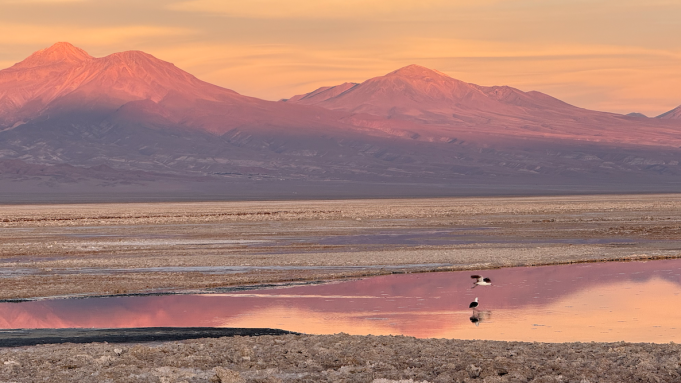
No one wants to be that guy waxing on about how beautiful the sunset was on vacation—but what if it was a double sunset? One that seemed to wash the world in pinks and purples, turning an imposing volcanic mountain range in the distance into a confection? Then, imagine those color-changing mountains reflected in the briny water of desert salt flats, a mirage that ripples when local flamingos fly by in twos and threes. The effect is panoramic, like being inside a pastel watercolor, and frankly, it’s emotional.
By my count, I had at least five “bucket list” experiences on a weeklong trip to the Atacama Desert in Chile, known somewhat unfairly as one of the driest places in the world. That makes Atacama sound hostile, unwelcoming—which it could be if a luxury tourism boom hadn’t shaped the Antofagasta region around the town of San Pedro de Atacama. About 90 minutes from Calama and Chuquicamata mine, one of the largest sources of copper in the world, is the equivalent of a Big Five geological safari. Visitors can experience massive red dunes that earn nicknames like Moon Valley and Death Valley; canyons carved with 4,000-year-old petroglyphs; hundreds of burbling, spouting geysers; one of the world’s best dark sky territories, blessed with few, if any, rainy days; and the aforementioned salt flats flanked with three species of flamingoes. About 150 volcanoes in the Atacama Andes—including Láscar, Chile’s most active—create this shape-shifting environment that’s as active as the travelers cresting it.

Golden hour at Tierra Atacama
Laura Dannen Redman
Wealthy and well-traveled Brazilians, a mix of CEOs and celebrities, were the first to seek out what Atacama offered, checking into adventure lovers’ Explora Lodge (open since 1998); Awasi, an ultra-luxe South American entry with a 3:1 staff-to-guest ratio and Relais & Châteaux credentials; and Nayara Alto Atacama, a high-end, truly sustainable lodge at the entrance to a pre-Incan archaeological site. In the last few years, the “stealth wealth” set has started to arrive from the U.S. and Canada, looking to spend big on one-of-a-kind memories, and the hospitality has grown in response. Luxury tented camp Our Habitas Atacama arrived in 2023, and Abercrombie & Kent partnered with Nayara on an experience-rich exclusive camp, hosting no more than six guests per night (September to March).
Tierra Atacama is among the oldest—and newest—lodges in Antofagasta, set on the edge of desert oasis San Pedro de Atacama since 2008. Chilean founders the Purcells, who went into hospitality with a trio of Tierra lodges and Ski Portillo, a popular ski resort in the Andes, made the decision to sell Tierra during the pandemic. Following a $20 million refurbishment under its new owners, Australian Baillie Lodges, the all-inclusive reopened in April 2025 with the look, feel, amenities, and opportunities to rival any top-tier safari lodge. Consider the bar raised: Tierra did a gut renovation, leaving just the cedar bones and an adobe mud brick entrance from its earliest days as a cattle corral, and emerged with a warm, modern, sleek yet unfussy escape. The desert is at your doorstep, so swap out the Prada for Patagonia. At the main lodge, floor-to-ceiling windows flank an airy, open-concept lounge and bar with floating fireplace, all-day restaurant with a show kitchen, and a terrace leading to the gym, spa, steam room, indoor/outdoor pool and Jacuzzi. The design is still deeply rooted in Chilean tradition: Some 40 local artisans contributed to the art and stone carvings on display, hand-woven textiles, hand-painted maps, and the gathering of travertine marble to serve as the cool, grounding base throughout the property.

A Tierra Oriente room, starting at $1,820 per night, all inclusive.
Tomas Encina Retamal
Fewer guest rooms (28 down from 32) means more space for a new two-level apartment and four suites, each the kind of extra-indulgent hideaway that makes it hard to leave. Suite guests have access to a private guide and driver (Awasi also offers this perk), though visitors might not want to leave once they settle into the hemp-linen bed beneath one of the four alpaca wool throws provided. Turndown has never felt so good as you take off dusty boots, well worn after a day of hiking through Devil’s Canyon, and settle into a standing tub that could double as a private pool (there’s one of those, too). The hanging fireplace, seemingly lit by house elves, pairs nicely with the gratis bottles of spirits and Chilean wine. In addition to the thoughtful amenities supplied to all guests—foot-tall water bottles, backpacks, sunscreen, lip balm, chessboards, and plenty of reading material—a handcrafted welcome gift arrived each night, be it knit booties made of local sheep’s wool or hand-poured vegan candles.
Meals are hyper-locally sourced, in part from the garden out back tended by the head of grounds—who also doubles as the yoga instructor—and serve as an education to the flora and fauna of the desert. Take, for instance, the purple welcome drink made of an infusion of rosemary, ayrampo seed, lemon juice, water, and sugar, which was so refreshing, our group asked for it nightly as an aperitivo. Another highlight was Tierra’s take on an elevated backyard barbecue (a bit of Aussie culture thrown in here): Staff start tenderizing a lamb early in the afternoon to be flame-grilled alongside beef, pita, peppers and zucchini, and guanaco, a relative of the llama native to South America. To close out the night, guests walk a short path to the on-site telescope for guided stargazing. The Milky Way is visible to the naked eye, along with the Southern Cross and indigenous constellations in the shape of baby lambs and foxes with pointy ears. With a telescope, we could see into the past, 16,000 light years away.

The Atacama Desert is one of the top dark sky territories in the world.
It’s not all moonbeams and starlight out here. In addition to Chile being the world’s leading copper producer, the Salar de Atacama supports one of the world’s largest lithium reserves, extracted from the brine beneath the salt flats. It’s a complicated relationship: Every ton of lithium requires 326,000 liters of water to extract, typically through wells and evaporation processes, thus changing the pH level of the lagoons and drying out an already notably dry desert. Two companies—one American, one a Chilean public-private partnership—have permits to continue lithium extraction in the Salar for at least another 20 years, bringing in billions in taxes alone. Not strictly a boon for the economy, bust for the ecology, the future of lithium extraction includes a lower-impact direct lithium extraction could significantly reduce the environmental footprint.
Meanwhile, the growth of the luxury tourism sector helps diversify the local economy, putting money back in the hands of the local indigenous communities. The Atacameño, of which there are at least a dozen distinct communities, have managerial rights to the most iconic natural attractions, including the Salar. The notion of responsible tourism is still fledgling in the region, as each community gets to dictate the hospitality experience within their bounds. Want to build a hotel at 14,000 feet, right next to the geysers? They can; they are. Prefer to set strict rules allotting only a handful of visitors each morning? Done.
Local guides and drivers speak seriously about being good stewards of the environment, opting for additional courses on geology, flora and fauna, and archeology in addition to the medical training they receive. A good guide is the true luxury—one who can help you go from seeing a place to feeling it, to understanding why it matters. Access to nature has become one of the greatest commodities since the pandemic, and the Atacama is filthy rich in that regard.
Thankfully, the guides—the entire staff—are terrific at Tierra, making the lodge feel like a shared home. We all enjoyed the nightly “show”: the sunset behind Licancabur volcano, a 19,409-foot stratovolcano on the border with Bolivia that guests can view from their suites, the lodge, even the spa’s relaxation room. Sundown brings out those pastel purples and pinks, stopping everyone in their tracks.
“Every day is different. Every day is amazing,” says waiter Rex, admiring the view. An India native who had been in Chile for 15 years (and here in San Pedro de Atacama for four), Rex bikes home every night and says he doesn’t even need a flashlight. “The stars light the way.”
Tierra Atacama rates start at $1,820/night for an Oriente room, inclusive of meals, open bar, daily excursions, use of spa, and airport transfers. Suites are from $3,500/night.
instagram:
Error: No feed with the ID 1 found.
Please go to the Instagram Feed settings page to create a feed.









